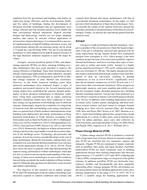Description
Aerogels, phase-change materials (PCMs), and vacuum insulation panel (VIPs) are the three emerging technologies that havepotential to significantly reduce building-envelope-generated (wall, roof, etc.) energy loads. Although performance characteristicsof these technologies have been well established in numerical simulations and laboratory-scale experiments, there is ageneral lack of real application data demonstrating their energy-saving potential. In this work, we use a combination of outdoortest structures located in Albuquerque, New Mexico, and a façade panel platform located in Boston, Massachusetts, to investigatethe field performance of these advanced technologies. The following configurations were examined: 10 mm (3/8 in.) thick aerogelblanket (R-0.7 m² x K/W) with reflective facings in the roof and gable envelopes of a test structure in Albuquerque, PCM (5 mm[0.2 in.] thick sheets of a shape-stabilized PCM) in the ceiling of a test structure in Albuquerque, and a VIP assembly (25 mm[1 in.] extruded polystyrene [XPS] + 25 mm [1in.] VIP + 25 mm [1in.] XPS; R-5.28 m² x K/W) in the walls of a façade panel platformin Boston. The field data were collected during the summer season of 2014. Reflective aerogel and PCM configurations were foundto save approximately 38% and 2.5%, respectively, in the cooling energy demand through the ceiling compared to the referenceconfiguration built to standard insulation levels. In addition, PCM configuration showed as much as 4.5 hours of time shift indaily peak ceiling heat flux, with an average of 1.68 hours for the duration of the project—an attractive feature in regions withdynamic electricity tariffs. Façade test data showed a dramatic reduction in wall heat flux through the VIP wall assembly comparedto a similar-thickness expanded polystyrene (EPS) insulated wall assembly. Wall-generated cooling energy loads were determinedto be approximately 82% lower through the VIP wall assembly compared to the EPS wall assembly. This field study validatesthe superior thermal and energy performances of all the three novel technologies as established in numerical simulation and laboratorytesting data reported in scientific literature.
Citation: Thermal Performance of Exterior Envelopes of Whole Buildings XIII, Conference Papers
Product Details
- Published:
- 2016
- Number of Pages:
- 11
- Units of Measure:
- Dual
- File Size:
- 1 file , 10 MB
- Product Code(s):
- D-BldgConf16-38




